New England Forestry Foundation Purchases, Conserves 1,285 Acres of Worcester…
NEFF has conserved nine ecologically valuable forests across three…

With the 2024 United Nations Biodiversity Conference of the Parties (COP16) underway in Colombia, we here at New England Forestry Foundation (NEFF) want to highlight the key tools in our toolbox for protecting biodiversity on managed forests: our two sets of Exemplary Forestry standards, which NEFF’s expert foresters and ecologists have designed to improve wildlife habitat connectivity and biodiversity, as well as to mitigate climate change, grow and harvest more sustainably produced wood, and more. One set is tailored to the Acadian Forest region of northern New England, and the other to southern New England’s Central and Transition Hardwood forests.
At COP16, nations have updated the world on the progress they have made toward meeting major goals agreed upon at COP15, most notably to protect 30 percent of Earth’s lands, oceans, coastal areas, and inland waters by 2030. COP15 also set four goals for 2050, and we’re pleased to see that Exemplary Forestry supports two of them: 1) to maintain or enhance the integrity, connectivity, and resilience of all ecosystems; and 2) to halt human-induced extinction and restore populations of native wild species to healthy levels.
Exemplary Forestry primarily helps biodiversity when it’s used to manage a parcel as one piece of a much larger jigsaw puzzle, though it can also make a difference for standalone parcels when, for example, its standards call for protecting soils and wildlife trees like snags. These steps benefit smaller animals like woodpeckers, the Northern Flying Squirrel, and our struggling native bat species, even on a property with few nearby forests.
Forests managed with the Exemplary Forestry work in balance with other managed forests as well as unharvested ecological reserves across the landscape to collectively provide much-needed habitat types. These ecological reserves are crucial to addressing the biodiversity crisis, and NEFF is committed to ensuring our managed lands work in concert with them region-wide.
This blog post will take a look at NEFF’s landscape-scale approach to forestry—here’s our glossary of forestry terms if you need it—with the Canada Lynx as our case-study critter. First up, let’s learn about the lynx and its habitat needs.
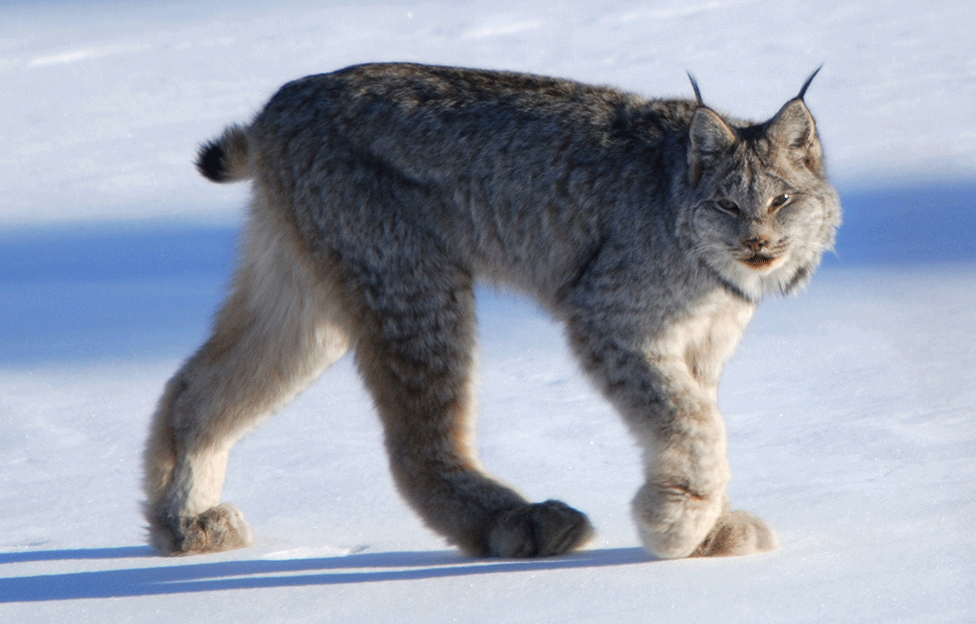
Canada Lynx by Keith Williams, Wikimedia Commons/CC BY 2.0
Scientific name: Lynx canadensis
In New England, the federally threatened Canada Lynx is found in the northern forests of Maine, New Hampshire and Vermont. Several adaptations allow this mid-sized cat to live in harsh winter conditions, including a dense winter coat and excellent night vision that serves it well when days grow short, but their feet are what really set lynx apart.
Their snowshoe-like paws have a large surface area relative to the lynx’s weight, and they become even broader when the cat is on the move thanks to easily spread toes. Add in some thick fur between the toes, and you’ve got feet that move smoothly over soft, deep snow.
The lynx primarily hunts Snowshoe Hare, so much so that lynx will only settle in territories that have established hare populations. They stalk and ambush hare and other prey from the ground even when there’s deep snow cover.
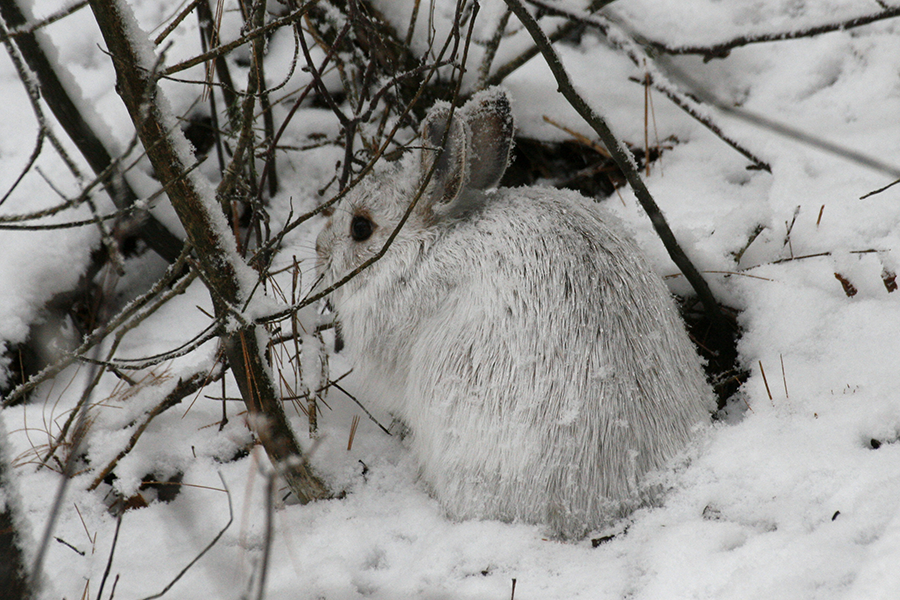
Snowshoe Hare, Larry Master
Snowshoe Hares’ preferred habitat is young and dense softwood forests, and where Snowshoe Hares go, Canada Lynx follow. In northern New England, this type of young forest grows following timber harvests or large-scale natural disturbances.
Canada Lynx have diverse habitat needs beyond the smaller patches of young and regrowing forestlands where they do their hunting. Much of the rest of their life cycle involves traversing large, wooded territories; the average Maine male lynx has a home range of 20 square miles, and the average female has 10 square miles. They travel through corridors of mature conifer forest in these large areas to meet their needs and live their lives, including to find mates, and raise and teach their young.
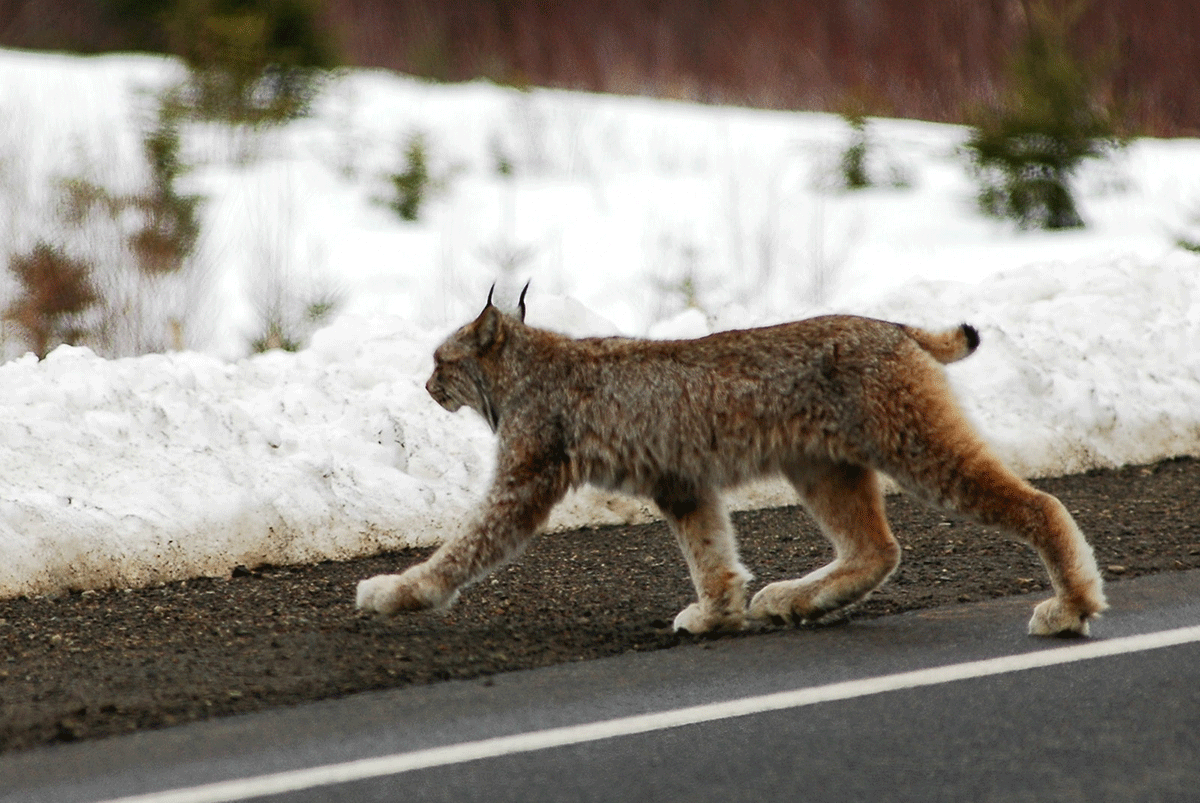
Ensuring the Canada Lynx has its habitat needs met keeps them away from dangers like road crossings. Photo: Jeremiah John McBride, Wikimedia Commons/CC BY-ND 2.0
Exemplary Forestry is a forest management approach that prioritizes forests’ long-term health and outlines the highest standards of sustainability currently available to the region’s forest owners for three key goals:
When it comes to wildlife, Exemplary Forestry looks at how its implementation could make landscape-scale improvements by meeting the needs of what’s called “umbrella species,” or species that have habitat needs that in turn encompass the needs of many other species. Exemplary Forestry standards call for managing specific proportions of the landscape to benefit a few designated umbrella wildlife species.
NEFF’s Acadian standards are based on two wide-ranging umbrella species from the Acadian Forest region: the Canada Lynx and the American Marten. Marten need large tracts of forest that include blocks of mature and closed canopy stands with travel corridors between them, and lynx need large, forested areas with patches of regenerating conifers connected by travel corridors of mature forest.
These two mammals have been deemed umbrella species because taken together, forests managed to protect their habitat will collectively provide habitat for 85 percent of other forest mammals, birds, reptiles and amphibians.
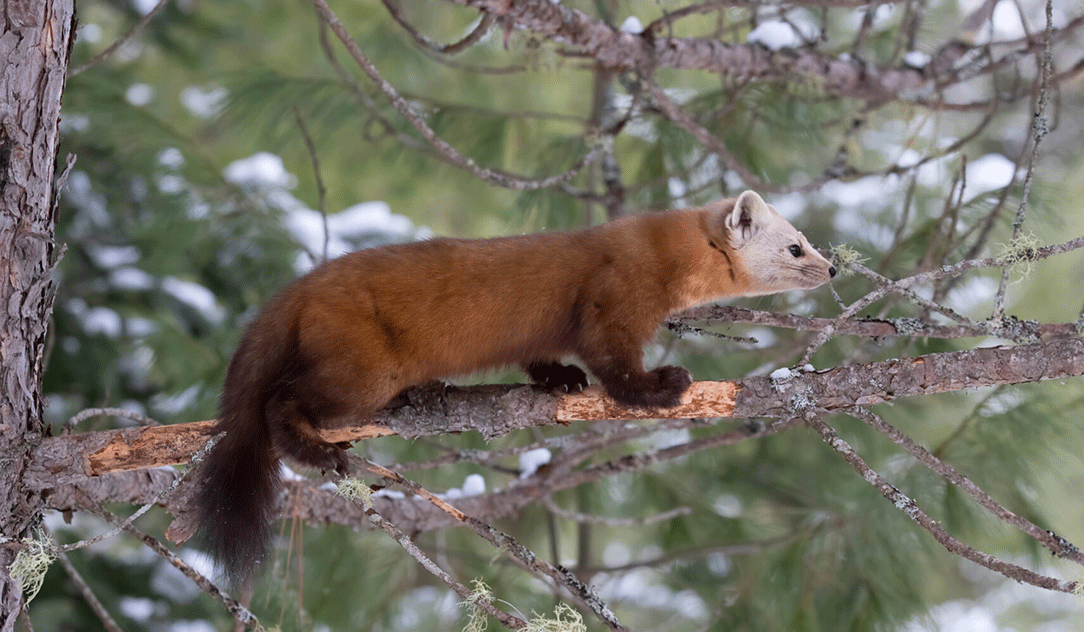
American Marten
NEFF scientists, working with forest and wildlife scientists as well as conservation professionals, assessed the habitat needs of vertebrate wildlife native to the Acadian region, and then compared them with an analysis of the actual habitats that currently exist. This revealed that existing conditions do not match well with the recommendations of forest and ecological science; a shortage of regenerating forest patches—Snowshoe Hares’ favored hangout—is of particular note to this blog post. The Acadian standards are intended to correct the imbalance between needed and existing native fish and wildlife habitats, and then to sustain them. The standards therefore call for:
Practicing Exemplary Forestry overall results in a diverse distribution of tree ages and sizes, and this includes having 10 percent of the total forest area in stands of big, multi-aged trees.
To provide an example, we’re now going to take a look at how landowners in a particular landscape can start to determine if their forest is a good fit for implementing lynx habitat, and then how they would go about creating that habitat.
In Western Maine, NEFF uses online habitat-mapping tools available through the state fish and wildlife agency to assess the contribution each family-owned woodland can make to improving Umbrella Species habitat in the Acadian Forest.
Called the Beginning with Habitat tool, it helps identify forested properties that are larger than 75 acres, mostly undeveloped, located near conservation areas, or are known to provide important habitat to native fish and wildlife. NEFF properties that are part of a block of unbroken forest due to their value to wildlife and biodiversity are prioritized. Even small properties can sometimes contribute outsized benefits to upgrade Umbrella Species habitat.
NEFF runs just one targeted wildlife habitat program, and it helps family forest landowners improve native fish and wildlife habitat in Western Maine using the NEFF Exemplary Forestry standards. While habitat features that benefit a truly wide range of animals—such as large dead trees, large logs on the ground, and large living trees—are in short supply in the Acadian Forest, which forest practices the program recommends depends on the conditions on the target property.
However, landowners with very large holdings and those with smaller holdings in lynx country can still implement similar management by planning harvests to maintain large areas of forest cover that include a mosaic of different age classes. This promotes a steady supply of prime hare habitat over time, as well as a more even supply of timber ready for harvest. When landowners harvest to create patches of regenerating, young, even-aged conifer forest, they are advised to retain some patches of older trees to benefit other wildlife species and to keep very large trees. Landowners can further benefit lynx by maintaining wide buffers of mature forest along stream corridors and shoreland areas that can serve as travel corridors for lynx, while also protecting water quality and providing habitat for hundreds of other wildlife species, from salamanders to moose.
If you are thinking about managing your property to create habitat for native wildlife, we recommend visiting NEFF’s Our Process page to get a sense of what it’s like to work with a licensed forester and to create a management plan. The suite of resources provided by the American Forest Foundation’s My Land Plan site should also prove helpful.
Want to learn more about New England’s lynx? We recommend Northeast Wilderness Trust’s recent blog post, “Rare Lynx Sightings Put Carnivores and Wildlands in the Spotlight”
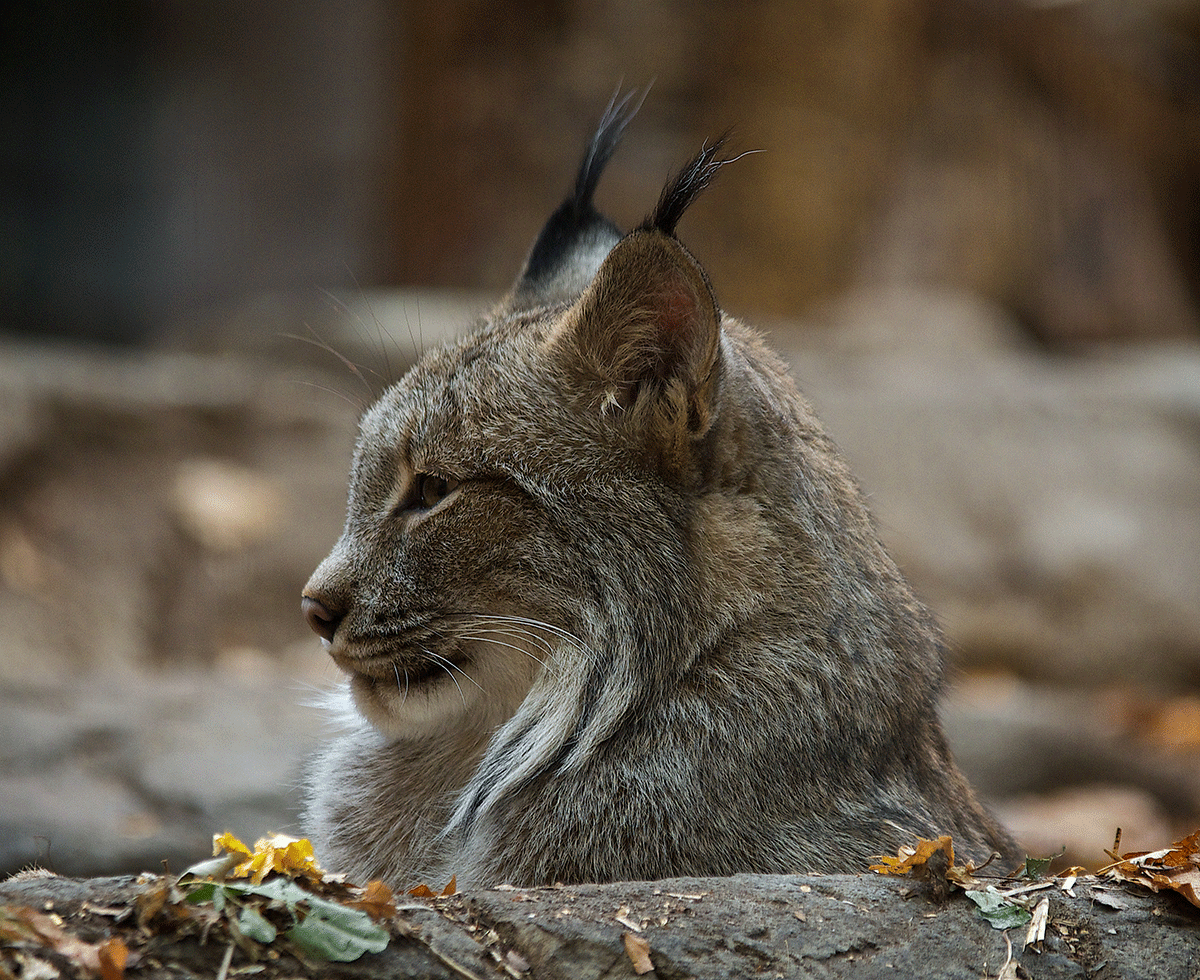
David Marvin, Wikimedia Commons/CC BY-NC-ND 2.0